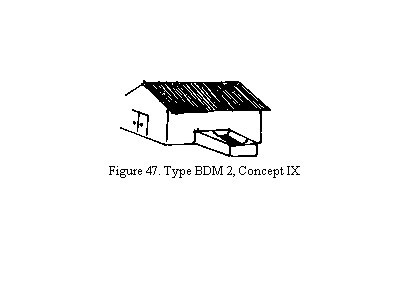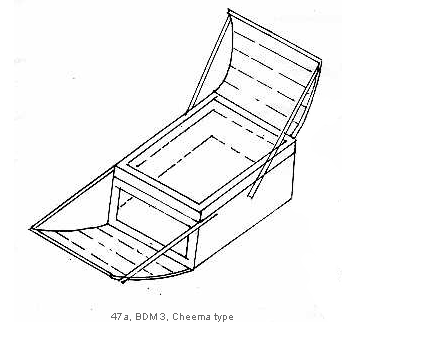Box with reflectors contd:-
Box with double reflector/Box with three reflectors/Box with four reflectors/
Box with four plus four reflectors
The Gosh type cooker would work well during summer in most part of India but Reflector during winter, at least in north India, additional boosters would be essential and this has resulted in the development of the box-type cookers with double reflectors. In Type BDM 1 (Figure 45) Agarwal adds (1981) another reflector at right angles to the first, his drawings do not suggest any mechanisms for tilting, which would be essential. But een without such tilting mechanisms Agarwal reports faster cooking during October. In Type BDM 1a, (Concept VIII, the author suggests two reflectors, both with tilting facility. This design worked well reducing the cooking time (Figure 46).
Concept IX, Type BDM 2, (Figure 47) presented by the author in this review envisages incorporating the cooker with two reflectors inside the house as illustrated (Kundapur 1995). Advantages are many and it is very easy to incorporate the cooker in the house. In our country lowery easy to incorporate the cooker in the house. In our country low-roofed huts are common and in all such cases this design could be used.

The author feels that even in multi-storied buildings, such extensions could be provided in every floor at proper height to place this type or other designs of cookers, such that, cooking could be done from inside the house.

The above concept was conceived during 1980's but I do not wish to make any claims on the same. I note with interest, that such a design is now being used, and finds a mention in SCI site. The Wall Oven found at SCI site is of this type, but only difference is that it does not have a reflector where as my design has two reflectors. it issuggested that solar Cooker enthusiast anddesigned Mrs Barbara Kerr designed this type ofCooker. Later, probably it was Prof. Paul Funk who set it up.

Wall Oven ( Source SCI site )
Source:- TIDE., March 1998, 8-1, pp 1-37, For Comments, suggestions,contributions contact < arkundapur@yahoo.com>
In this type of cooker, one of the reflectors has to be adjusted seasonally while the other requires daily adjustments. In Cheema's ( 1984 ) design the lid opens to form double reflector one above the other.
Prof. Cheema had presented an interesting variation ( BDM 3 ) as early as 1983. This is a double reflector design one on top of the glazing and another reflecting the light thropugh a side window. The arrangement appears to be interesting and Cheema reports a stagnent temperature of 206º C compaared to 164 º C of ordinary coker.

Sri. Sankha Subhra Datta of Jalpaiguri, a sub Divisional town of West Bengal, has come out with an ingenious new concept for Box type Solar Cooker ( Designed by him in 2002 ) . I consider it as a new major Design on the scene and designate it as BDM 4. It is a rectangular construction with two reflectors, making it possible for trapping maximum Solar Radiation. For achieving this the Cooker has to be inclined and while doing so to prevent the cooking vessel from spilling over, he has positioned them on tilting stand. There are 4 such stands for 4 cooking vessels of 1 lit capacity. The inventor report that the water reached boiling point with in 105 mins, stagnation temperature recorded was in the range of 1480C . There is provision of for adding two more reflectors if need be. The cost of construction is estimated at Rs. 2000/-. I am sure this Cooker performs better than regular Ghosh type Box Cooker with one reflector. For further details one could contact sankhasubhradutta@yahoo.com ( This is a new design introduced in this site on 24th Feb 2005. It was designed by Sri SS Dutta in 2002 )
To improve the performance further three
reflector designs were proposed and the Reflectors Concept X
(Type BTM 1, Figure 48) proposed by the author does just that.
Two configurations were tried, they did not, however, reduce the
cooking time by one thirds, besides, adjustment was also
cumbersome. Of the two proposals, the one with configuration 2
was better. The reflectors could be adjusted and tilted
individually after setting. The box has to be turned to face the
sun. the space between the mirrors could be fitted with
triangular mirrors to increase the efficiency further. It is
further proposed that these additional mirrors would come as
‘add-ons’ (to reduce cooking time) rather than as part
of the cooker. The above photo is from SCI site, but I could not retrive the details regarding the Scientist/inventor and test results if any. Better and ideal confugaration could be to have
a two triangular reflector adjecent to the main reflector as shown in
the diagram. As Prof. Bowman had observed a triangular reflector
casts a better image on the cooker. ( Fig 47b ) Box type cooker with three
reflectors available in the market Details and principles of the
design. ( source SCI ) Source:- TIDE.,
March 1998, 8-1, pp 1-37, For
Comments, suggestions,contributions contact < arkundapur@yahoo.com> Halacy (1974) had gone a step further by
suggesting a cooker with four reflectors (Figure 49). Bowman,
Blatt (1979), who tried to build such a cooker, found that
adjustment of the reflectors took a long time and required
several supports. The cooking time was not reduced by one-fourth
as compared to the single mirror cooker. However, it is essential
that a designer know about the existence of such a design, as it
would avoid any further attempts in designing such a cooker. Recently this design, namely
Halacy type 4 reflector seems to have surfaced and we find it
being referred to in Solar Cooker International (SCI) site. Halacy type Cooker ( source SCI site ) Box with four plus four
reflectors Maria Telkes (1959) was probably the first lady
to design a solar cooker,Reflectors popularly known as the Telkes
design which was one of the best in the series and could develop
a temperature of 2250 C. The box was a rectangular
double-walled insulated box with a door on each side. The box had
double glazing fixed at the top, and the there were four main
reflectors set at an angle of 60o to the horizontal.
The corner spaces between these main reflectors were fitted with
four triangular mirrors. The insulated box had a cradle frame to
hold the cooking vessel and to assist in tilting. The whole
cooker was mounted on to an ‘A’ type frame. Hoda (Type
BFF 1a) suggests some improvement in the stand to reduce the
cost. Type BFF 1b, designed in Senegal, has a funnel – like
reflector. Telkes also suggested a modification such as a box
with an aperture set at 450. Bowman, Blatt (1978)
tried to maximize the dimensions of the Telkes cooker. The outer
‘A’ type of stand was eliminated, but the inner cradle
was retained. Alzek reflectors were used instead of glass
mirrors. A new type of insulation material foam glass was used to
make the box. A temperature of 2250C was reported
(Figure 50). The author tried this variation, that is concept XI,
here at Udupi, but as foam glass was not available, a box of GI
sheets was used and insulated with mineral wool. Regular glass
mirrors a transparent PVC sheet was used on top. To effect the
tilting, a steel frame support was incorporated. The assembly
worked well but compared to the single or double mirrored Gosh
type design the cooking time was not reduced to one-fourth as
expected. (Type BFF le, Figure 51). As the Telkes design was costly but more
efficient, Rose (1981) of VITA designed a cooker based on similar
design but with cardboard (Type BFF 1f). Muzumdar (1980) made a
similar design also with cardboard, but the box had only a single
polyester sheet as glazing, the reflectors were also made of
cardboard and coated with aluminized polyester. The cost of the
unit was claimed to be just Rs. 95/- (Type BFF 1g). Type BFF 1h
is a patented design from the US (Patent no. 4 292 957). Weyer
(1980) uses GI sheets as reflectors (Type BFF li). Source:- TIDE.,
March 1998, 8-1, pp 1-37, For
Comments, suggestions,contributions contact < arkundapur@yahoo.com> For details regarding testing of solar cookers please click here For easy
NAVIGATION use this chart. OTHER LINKS are
found under References S to W click here for
comments received For Comments,
suggestions,contributions contact < arkundapur@yahoo.com>






PREVIOUS PARTBox type designs
NEXT PARTIndirect types